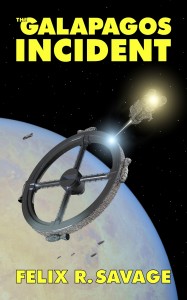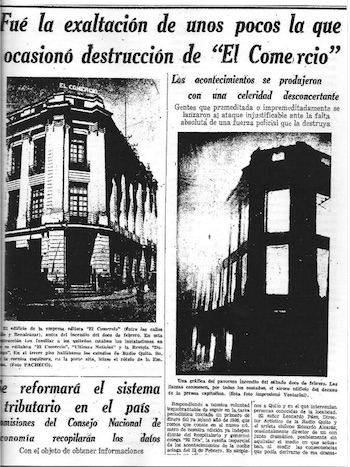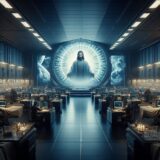 The Galapagos Incident
The Galapagos Incident
Chapter 10
Botticelli Station drifted through Venus’s atmosphere at an altitude of barely 80 kilometers. The same PLAN missile that annihilated its hub, ruptured its tokamak, pulverized its main drive nozzle and had exited through the Planetary Science Department, tearing a wound that continued to bleed shards of furniture and lab equipment into the clouds. These fell straight down. The station, however, still contained a lot of air. Though not in the least aerodynamic, it was somewhat buoyant in Venus’s syrupy atmosphere. It sailed through the clouds on a sub-orbital trajectory, with the auxiliary boosters thrusting flat-out to maintain altitude.
Captain Sikorsky had executed the only evasive maneuver available to him. With PLAN ships closing in on him in three dimensions, he had nipped between them, straight down towards the planet—the one course that the PLAN had not interdicted. It was the three-dimensional equivalent of dashing on foot across a busy highway. The station hadn’t made it through unscathed. Flashing through missile range of the nearest PLAN ship, it had been targeted and consequently hit. Sikorsky had just managed to make his planned course correction before the fusion drive failed. As Botticelli Station ploughed into Venus’s troposphere, he had reversed thrust. (This was the final, brutal jolt that Elfrida and dos Santos had felt.) This flattened the station’s plunge out into a long shallow glide—giving them about forty-five minutes, instead of two, before they would crash-land on Venus.
Hoping to avert a fresh panic, Captain Sikorsky had not mentioned any of this in his announcement. He and the surviving men and women of the Operations Department were frantically trying to perform, by hand, a complex series of tasks that boiled down to connecting the station’s backup generator—a chain of hydrogen fuel cells—to its electrically-powered auxiliary boosters. If successful, this would give Botticelli Station enough thrust to regain orbital altitude. The engineers were obliged to spacewalk to the auxiliary boosters to reroute their power supply lines. Elfrida and dos Santos saw them, EVA-suited insects crawling along the booms, as they themselves inched around the outside of the station. “What on earth are they doing?” Elfrida panted.
She was speaking to herself, as the two-way radios in the EVA suits were not working. Everything electronic in the lifeboat had been slagged.
Including the airlocks.
They had egressed through the mechanical escape hatch at the back of the cabin, and were now inching around the curvature of the station towards the hole in the Planetary Science Department. It was an exercise similar to climbing a mountain covered with an anti-erosion net … 80 kilometers up, with the fires of hell waiting below. Elfrida clamped her gloves onto corners of boulders sticking out through the mesh of the shield envelope, transferring the clamp of her belt tether from one strand to the next. The fog whipped over them, driven by the wind that swept around Venus in as little as four days, which was blowing at a 30° angle to the station’s heading. If not for the pressure-activated servos that enhanced the strength of her gloves, she would have been torn right off the rock.
A gap appeared in the clouds below; she thought she saw a glint of sullen fire. Couldthat be the surface, tortured by countless asteroid impacts into a new cycle of volcanic activity? Despite her own plight, a thrill of excitement pulsed through her. Right now she was the closest to Venus she’d ever been. And thanks, ironically, to the PLAN, she may have achieved one of her life goals of seeing the surface with her own eyes.
A chasm choked with office décor yawned. She and dos Santos dived out of the wind, into the wreckage of the Atmospheric Analysis lab. Communicating by hand signals, they edged around a crevasse lined with melted wiring and smashed UV plates. It was only then—as Elfrida caught sight, far below, of a fragment of palm branches, the whimsical design which had adorned the ceiling of this lab, dedicated to Venus’s transformation into a tropical paradise—that she realized they were walking on what had been the ceiling of the lab. They were no longer weightless. Not magnetism held them down, but Venus’s gravity—at 0.9 gees, the closest in the solar system to Earth’s.
The door irised as they approached. Two people in EVA suits dashed out, carrying what looked like a massive coil of electrical cable. Dos Santos spread her gloves: wtf? They passed into the Biological Engineering lab.
Despite the functioning doors, this lab was also depressurized. The transit of the PLAN missile through the next-door compartment had buckled its containment. An avalanche of debris lay piled up against the near wall. Everything not splarted down—screens, tablets, sample slides, the perspex tanks in which the scientists were attempting to raise green-slime-compatible prokaryotes—had been sucked against the leak as the air rushed out. From the ceiling, a.k.a. the erstwhile floor, hung benches like branches bearing clusters of scanning electron microscopes and analysis equipment. Elfrida felt disoriented, and sick to her stomach.
The next door took them into the throughfare corridor. They jumped down to the new floor of shorted-out UV plates, formerly the corridor’s ceiling. Of course, this segment of the corridor was also depressurized. The missile had punched straight through it. Sulphuric fog boiled through the hole corresponding to the crevasse in the Atmospheric Analysis lab.
A person in an EVA suit stumbled out of the Operations Department and beckoned them with both arms. Beyond the next pressure-lock, he removed his helmet, revealing corkscrew curls and a cheek tattoo of a playful dolphin. He was Aryeh Litvinek, one of the techies from Systems Maintenance. A bloody bruise half-closed his left eye, making it look as if the dolphin were balancing a ball on its nose.
Elfrida removed her own helmet, inhaled heady high-oxygen air.
“Aren’t your comms working?” Litvinek demanded.
“No,” dos Santos said. “What’s going on?”
“All right. Go and round up the casualties from Residential. Get first aid kits from the emergency lockers, as many as you can carry. Stretchers, too. We need to get everyone assembled here, pronto.”
Litvinek dashed towards Electrical Propulsion Systems.
“Oh,” he called, without stopping, “and wear your helmets. We think there’s only the one containment breach, but we don’t know for sure.”
“Wait!” dos Santos shouted after him. “What casualties?”
“All of them,” Litvinek shouted, and vanished through the airlock.
“Oh my dog,” Elfrida said.
“Typical Russky,” dos Santos grumbled. “Send the women to tend the wounded, while the men do the important work …” Her face was an odd shade of yellow. “Come on. There should be an emergency locker at the end of this corridor.”
While Elfrida and dos Santos embarked on their grisly round of the cabins, Captain Sikorsky initiated two new procedures. The engineers were increasingly pessimistic about making it back into orbit. The math said it was doable from as low as 50 kilometers, but the hydrogen fuel cells were there to generate emergency power for the station’s life support functions, not its engines. Their comparatively meager trickle of electricity might give the attitude boosters enough thrust, but reckoning with the complicating factor of an atmosphereout there, maybe not. Therefore, Sikorsky requested infrared and radar scans of the ground with a view to crash-landing. This would be his absolute last resort. Nowhere was the surface of Venus cooler than 600° Celsius. To the question of “How long could a space station survive on Venus without melting?” the backup flight computer—an MI both stupider and more insolent than the late hub—responded with a stream of equations that lacked crucial variables, computerese for, “If you’re even thinking about trying this, i diskard you, foolish mortals.”
The engineers’ third scheme was rather ingenious. The backup fuel cells ran on hydrogen, which also happened to be the propellant for the fusion drive. Botticelli Station carried tonnes of the stuff. What was even lighter than air? Hydrogen, that’s what. So they rigged lines from the hydrogen tanks to the Residential Department and the still-pressurized regions of the Science Department. They planned to vaporize the contents of the fuel tanks and pump the buoyant gas into every nook and cranny of the space station that still had intact containment.
Just as soon as everyone had been cleared out of the target areas.
****
Elfrida ground her fist into another panel of doorbells, opening the hatches of three cabins at once.
The cabins were stacked three deep on both sides of the throughfare corridor, and also along the side corridors that led off it like fishbones. Blocking this side corridor, a train of several stretchers, lashed together, waited for her to wriggle into her improvised harness and tow them away like a little mule. She needed help. There was no one to help her. She and Dos Santos had separated in order to check the cabins faster.
Three polyfoam sphincters gaped. A limp arm fell out of the bottom cabin, which had formerly been the top cabin. Elfrida stepped on the lip of the bottom hatch, nudging the arm aside with her boot, so that she could see into the middle cabin. ROGERS, SELASSIE, was not there; maybe he/she was one of the engineers working their eyeballs out to save Botticelli Station. Each empty cabin was a relief, each occupied one a fresh wall of dread to be climbed.
She jumped down again and pulled on the arm of LACY, MILO. He came out like an understuffed futon, his flesh soft and yielding under her fingers, a doper’s cubital port in his forearm covered with an UNVRP health seal. Yet another one of the colleagues she’d never met before, whom she was seeing for the first time as corpses. Or not-quite-corpses. Milo Lacy grunted when his head hit the floor.
“Sorry,” Elfrida said. “Oh my dog. Sorry.” She bundled him—easily; he was light—onto a stretcher, on top of a woman whose name she’d already forgotten again, who had not seemed to be dead but looked it now.
Leave the dead, dos Santos had told her after they parted from engineer Litvinek. Triage ‘em so we can get out of here faster. But it was harder than Elfrida had expected to tell which were which.
She used the open hatches as a ladder to climb up to the top, formerly the bottom cabin. There lay her COMLI colleague Jim Hardy. He smiled weakly. “I always knew you had what it takes, Goto.”
“Quick. They’re going to depressurize this segment.” Elfrida was a little hazy about the hack that the engineers were planning. “Can you walk?”
“Don’t think so.” He tried to prop himself on his elbows, fell back. Elfrida grabbed a blond-pelted forearm and hauled him towards the airlock. His pupils were dilated. “I’m an idiot. I took the stuff.”
Elfrida nodded. Some people had suffered broken bones when the ceiling abruptly turned into the floor, but all eight of her fatalities so far were people who had taken ‘the stuff’—the self-euthanasia ampoule provided, unironically, in each crewperson’s survival kit. In fact, she had a feeling that was what dos Santos had been working up to in the lifeboat, when she harped on the grisly end awaiting them: a choice between death by suffocation, acute radiation syndrome, or a drug cocktail which was supposed to be painless, quick, and failsafe. Color Elfrida unsurprised that it turned out to be none of the above. The UN was always getting the big things right and the little things as wrong as humanly possible. She wouldn’t have entrusted her death to them.
“Hardy, you’re heavy. Can you please try and climb down by yourself?”
Hardy flopped towards the pressure-lock. In effect he was heavily tranquilized. “It didn’t work,” he gasped. “Damn stuff didn’t work.”
“Maybe you didn’t read the instructions properly.”
“I never thought I was the type to take the stuff.” Hardy’s head and shoulders hung out of the cabin. “I wish I hadn’t taken it. I was just … so … damn … scared …”
“Come on. Hup.”
Hardy fell out of the cabin on top of her. They crashed against the stretchers. Two or three other failed suicides slid off, and would have to be heaved up again. Elfrida’s eyes filled with tears.
“Goto, do you copy? Thees ees Sikorsky.” The captain’s voice crackled from her belt. She had been given a working two-way radio. “Vee are vaiting for you. Vot are you doing, powdering your nose? Hurry up, please.”
“Yes sir, coming, right away,” Elfrida babbled in response to these, the first words the captain had ever spoken to her personally.
Hardy, however, was in no hurry. “Why?” he asked, sitting on the floor with his legs splayed, an undamaged UV panel flickering beneath his crotch. “Why’d they attack us?”
Elfrida could have given any number of answers. They’re the PLAN and that’s what they do. Or: We were a big fat unarmed target and the Cheap Trick was away. Or, more speculatively: Maybe they want to stop the Venus Remediation Project. But she was exhausted and nauseated and the captain had just told her off, and so she said meanly, “Maybe they knew you were here.”
To read the other chapters of THE GALAPAGOS INCIDENT, click here.










